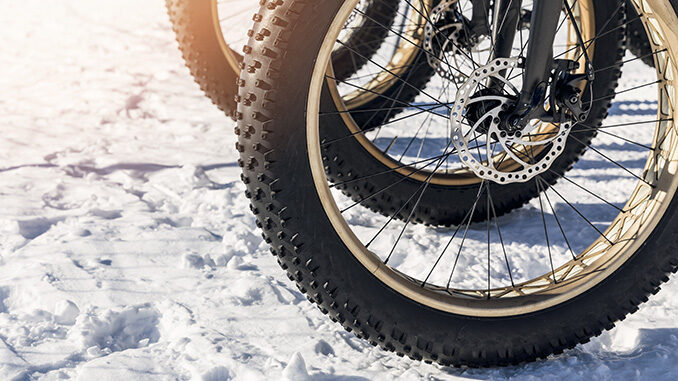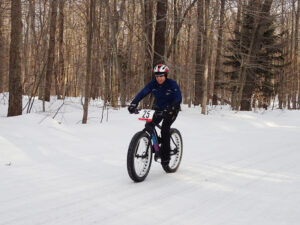
And why Winona Forest might just be the best there is for fat biking
By Stefan Yablonski

About 10 years ago, Matt Westerlund, 51, and his wife were really into snowshoeing. They’d go to Vermont to compete because there were none in Central New York.
He started showing up at meetings of the Winona Forest Recreation Association.
“I was interested in bringing a snowshoe race to Winona,” he said. “A few years later, that evolved to being the association’s president and helping to build an amazing team of volunteers and leaders.”
The first snowshoe race, Stone Wall Snowshoe Walk and Run, a primitive 10K race, required participants to leap over logs and stone walls on ungroomed forest trails, he recalled.
“Winter conditions are unpredictable,” Westerlund said at the time, promoting the event. “You may encounter deep snow, bitterly cold temperatures, blizzard-like conditions, logs to jump, limbs to duck, wet conditions, water holes, downed trees, steep up and down hills, snowmobilers, skiers and wild animals. It could be a bright, blue, clear winter day or it could be something much different. Prepare for anything. Regardless of weather, come to enjoy the day with fellow ‘shoers, in a beautiful forest.”
“And then fat biking came to town. It opened up new possibilities. You could have a duathlon on snow,” Westerlund said.
And so, SnoFatShu was born.
Twelve people took part the first year. Now that number has nearly tripled, according to Westerlund.
Does he have a fat bike?
“Oh yes, definitely. Actually I have two,” he replied.
Why two fat bikes?
“Fat bikes are exactly that — bikes with fat tires. This allows for flotation on snow; the wider the tire, the more the flotation. One of my bikes has fatter tires than the other. These fat tires, coupled with low air pressure, allow for grip and floatation in all sorts of conditions. You can ride them anywhere, in all kinds of conditions.”
The best, the ideal, is hard-packed snow, he added.
“It is like being able to ride on a frozen race track through the woods — an amazing and fun experience!” he said.
Winona Forest the Mecca of Fat Biking
“Locally, there are mountain bike groups making strong efforts to maintain trails in the winter, and I highly respect them all. It’s good for the sport. That said, Winona has 50 miles of groomed trails, across almost 10,000 acres. No one can compete with that, at least not in the Northeast,” he said. “As an organization, we made the decision seven years ago to invest heavily in this user group. We’ve invested tens of thousands of dollars on new trail construction and rehabilitation while simultaneously purchasing equipment to do the job.”
“Our group is made up of fat bike riders. We know what we like and that is what we built — and continue to build,” he added.
As an organization, they are always trying to build relationships with local businesses.
“As business partners, we both have much to gain. This year in fact, Murdock’s Bicycles and Sports in Oswego has been a huge supporter, donating a high-end fat bike for us to use as a fundraiser,” he said. “We have very loyal followers and when they see support from local businesses, they return the favor. I am hopeful Murdock’s has seen an increase in bike sales from Winona users due to their support of us.”
Winona currently organizes two fat bike winter events. One event is the SnoFatShu, a unique event that combines fat bike riding with snowshoe racing.
“To be honest, after participating in all kinds of events across the USA, this is my favorite event of all time. I love snowshoe racing and fat biking. Put the two together, and you get the best of both worlds. It is a duathlon, two sports in one event. You can do this as a team, or solo. Solo is the ultimate challenge,” he said.
Their other fat bike event is called the IdtaFat. There are distance options and a place for anyone in this event regardless of ability levels.
Some SnoFatShu participants race 20 to 30 endurance events in a given year, from half marathons to triathlons. SnoFatShu is a tune-up for them, Westerlund said.
The IditaFat is an annual event held the first weekend in March. The SnoFatShu will be held Feb. 11.
Information about these and other events can be found on the WFRA website, www.winonaforest.com and Facebook page.
Fat bikes, at least the concept, have been around for a long time. Cyclists wanted to keep riding even when the snow arrived, so they would fabricate all kinds of methods to extend their seasons.
Not until about 10 years ago did fat bikes really rise in popularity and did bike manufacturers believe there was a large enough market to justify producing them in large quantities.
Like any bike, it is up to you how much you want to spend. When purchasing a bike, you have the choice of frame material, carbon, steel, aluminum, as well as all the components that are added onto a bike. These all range in price. A great fat bike can cost $2,000. Fat bikes can reach $5,000 fairly easily. This is true of any bike. Lightweight materials add to the price.
Staying active in the winter months, especially in Upstate New York, is important for your health and wellness. Choosing fat biking is a really good option.
The fat tires provide additional stability that a regular bike cannot, making you feel safer. A fat bike has nubby wheels that vary in width from 3 1/2 up to 5 inches. These bikes also have wider wheel rims and frames.
Fat bikes look heavy, but they are amazingly lighter than you would think. While the intent was to ride on snow in the winter months, most people end up riding their fat bikes year round. They are fun. They are stable.
Normal base model fat bikes come in at around 33 to 36 pounds. More premium models, such as carbon fat bikes, are going to weigh in at 30 pounds or less.
Fat bikes can also be rented and ridden year-round at Greek Peak Mountain Resort in Cortland County. For more, see greekpeak.net.
